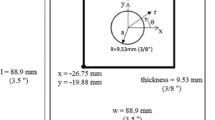Abstract
Novel method for a determination of residual stresses in orthotropic composite plates based on local displacement measurements by electronic speckle-pattern interferometry is developed and verified. The values of hole diameter increments in principal residual stress directions serve as initial experimental deformation. The technique is based on analytical solution of S.G. Lekhnitsky, which describes a stress concentration along the edge of central open hole in rectangular orthotropic plate under one-axis tension in arbitrary direction. A situation when principal directions of residual stresses coincide with principal axes of anisotropy is considered. The relations, which connect initial experimental data with residual stress components, are unequivocally solution of the properly posed inverse problem. An availability of interference fringe patterns, a quality of which is high enough for reliable recognizing of fringe orders at the hole edge immediately, is the essential experimental foundation of the approach developed. The accuracy of the proposed method has been assessed by two different ways. The results of residual stresses determination in rectangular composite plate are presented.










Similar content being viewed by others
References
Parlevliet PP, Bersee HEN, Beukers A (2006) Residual stresses in thermoplastic composites—a study of the literature. Part I: formation of residual stresses. Compos A Appl Sci Manuf 37(11):1847–1857
Stavrov D, Bersee NEN (2005) Resistance welding of thermoplastic composites—an overview. Compos A Appl Sci Manuf 36(1):39–54
Parlevliet PP, Bersee HEN, Beukers A (2006) Residual stresses in thermoplastic composites—a study of the literature. Part II: Experimental techniques. Compos A Appl Sci Manuf 38(3):651–665
Dubé M, Hubert P, Yousefpour A, Denault J (2007) Resistance welding of thermoplastic composites skin/stringer joints. Compos A Appl Sci Manuf 38(12):2541–2552
Lu C, Chen P, Yu Q, Gao J, Yu B (2008) Thermal residual stress distribution in carbon fiber/novel thermal plastic composite. Appl Compos Mater 15(3):157–169
Schajer GS, Yang L (1994) Residual-stress measurement in orthotropic materials using the hole-drilling method. Exp Mech 34(4):324–333
Sicot O, Gong XL, Cherouat A, Lu J (2003) Determination of residual stress in composite laminates using the incremental hole-drilling method. J Compos Mater 37(9):831–844
Pagliaro P, Zuccarello B (2007) Residual stress analysis of orthotropic materials by the through-hole drilling method. Exp Mech 47(2):217–236
Grédiac M (2004) The use of full-field measurement methods in composite material characterization: interest and limitations. Compos A 35(7–8):751–761
Cárdenas-García JF, Ekwaro-Osire S, Berg JM, Wilson WH (2005) Non-linear least-square solution to the moiré hole method problem in orthotropic materials. Part I: residual stresses. Exp Mech 45(4):301–313
Cárdenas-García JF, Ekwaro-Osire S, Berg JM, Wilson WH (2005) Non-linear least-squares solution to the moiré hole method problem in orthotropic materials. Part II: material elastic constants. Exp Mech 45(4):314–324
Cárdenas-García JF, Preidikman S, Shabana YM (2006) Solution of the moiré hole drilling method using a finite-element-method-based approach. Int J Solids and Struct 46(22–23):6751–6766
Baldi A (2007) Full field methods and residual stress analysis in orthotropic material. I linear approach. Int J Solids and Struct 44(25–26):8229–8243
Baldi A (2007) Full field methods and residual stress analysis in orthotropic material. II nonlinear approach. Int J Solids and Struct 44(25–26):8244–8258
Lekhnitsky SG (1963) Theory of elasticity of an Anistotropic elastic body. Holden-day, translation of 1950 Russian edition
Pisarev VS, Balalov VV, Aistov VS, Bondarenko MM, Yustus MG (2001) Reflection hologram interferometry combined with hole drilling techniques as an effective tool for residual stress field investigation in thin-walled structures. Opt Lasers Eng 36(6):551–597
Pisarev VS, Bondarenko MM, Chernov AV, Vinogradova AN (2005) General approach to residual stress determination in thin-walled structures by combining the hole drilling method and reflection hologram interferometry. Int J Mech Sci 47(9):1350–1376
Pisarev VS, Odintsev IN, Apalkov AA, Chernov AV (2011) Role of high-quality interference fringe patterns for the residual stress determination by the hole-drilling method. Vis Mech Process. doi:10.1615/VisMechProc.v1.i1.20
Laermann KH (2001) Reliable evaluation of measured data—an inverse problem. In: Juptner W, Osten W (eds) Fringe 2001–proceedings of the 4th international workshop on automatic processing of fringe patterns. Elsevier, Paris, pp 443–450
Rastogi P (2001) Digital speckle pattern interferometry and related techniques. Wiley, West Sussex
Maclead N, Kapur DN (1973) A kinematically designed mount for the precise location of specimen for holographic interferometry. J Phys E Sci Instrum 6:423–424
Shchepinov VP, Pisarev VS (1996) Strain and stress analysis by holographic and speckle interferometry. Wiley, Chichester
Lankaster P (1969) Theory of matrices. Academic, New York
Forsythe GE, Malcolm MA, Moler CB (1977) Computer methods for mathematical computations. Prentice-Hall
Author information
Authors and Affiliations
Corresponding author
Rights and permissions
About this article
Cite this article
Pisarev, V.S., Eleonsky, S.I. & Chernov, A.V. Residual Stress Determination in Orthotropic Composites by Displacement Measurements Near Through Hole. Exp Mech 55, 1225–1238 (2015). https://doi.org/10.1007/s11340-015-0015-3
Received:
Accepted:
Published:
Issue Date:
DOI: https://doi.org/10.1007/s11340-015-0015-3



